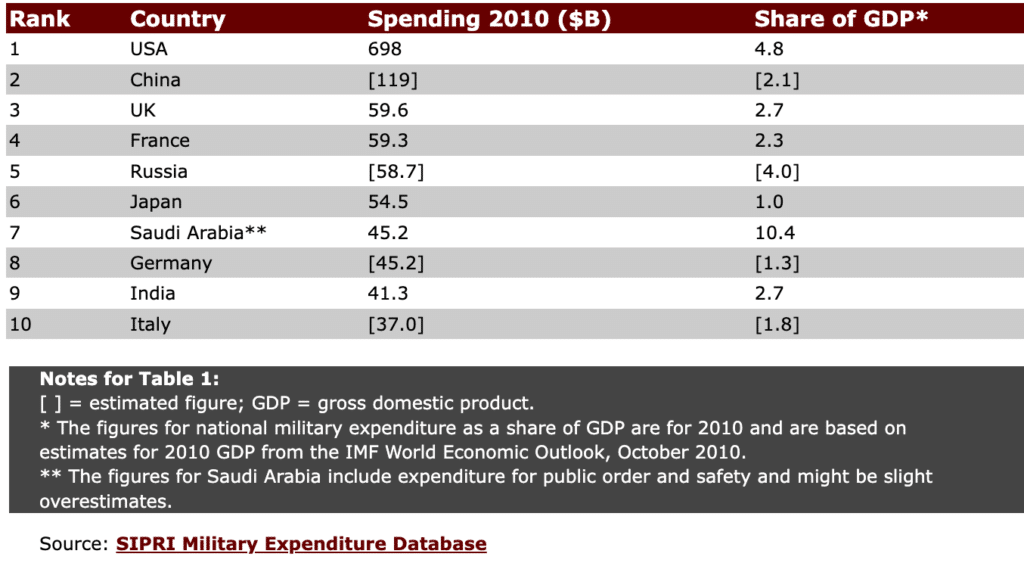by Susan Feiner
t ten years and counting, the wars in Iraq and Afghanistan are the longest in U.S. history. Not surprisingly, they are the most expensive, with total war spending poised to top two trillion dollars early this summer. These numbers are so huge it’s hard to wrap the mind around them.
Grab a pencil and paper so you can physically experience all those zeros: write down $791 and then write out the nine zeros you need to get to the $791 billion that marks spending to date in Iraq.
Then add $406 billion for total Afghani war spending.
Women the world over have reason to be concerned about U.S. military spending. Some simple, undisputed facts, drawn from reports by the Stockholm International Peace Research Institute, displayed in Table One put these staggering figures into perspective.
The U.S. government’s spent over $2,000 per capita on all aspects and accouterments of war. Fully 4.8 per cent of our gross domestic product on the military, only Saudi Arabia spends more (as a share of GDP); nearly six times more per year than China, the nation with the world’s second largest military budget, and 42 per cent of all the of the whole world’s military spending, a figure that includes what the government spends buying military hardware and software and paying personnel.
| Table 1. The Top 10 military spenders in 2010Spending figures are in U.S. dollars at current prices and exchange rates. Countries are ranked according to military spending at Market Exchange Rates (MER). |

In his final 1961 speech as president, Dwight D. Eisenhower, a life-long soldier, West Point Graduate, and Supreme Allied Commander in World War II, issued this apocryphal warning, “In the councils of government, we must guard against the acquisition of unwarranted influence, whether sought or unsought, by the military-industrial complex. The potential for the disastrous rise of misplaced power exists and will persist.”
Americans ignored Eisenhower’s warning and allowed the military-industrial complex to grow unchecked. As a consequence, valuable resources flow to destructive ends, and U.S. citizens, especially women, lose out.
Spending on the military counts for a huge share — 58 percent — of U.S. discretionary federal spending. If military funding were redirected to meet critically important social needs, the nation as a whole would reap enormous benefits.
Disappearing Education And Health
For example, the Congressional dollars allocated to Afghanistan in 2011 could have funded the enormously popular, widely recognized, and vitally important Head Start program. The 2011 appropriation for Afghanistan would pay for the next 15 years of Head Start! Instead, we face a national crisis in early child education — there are 2,528,896 children of low-income families eligible for Head Start, but only enough federal funds to provide 904,153 places. There are, in other words, more kids eligible for Head Start but left out, than there are in Head Start. The Head Start deficit is 1,624,743 seats per year. Neither these 1.62 million kids nor their parents are receiving the education and comprehensive care that Head Start provides.
| The 2011 appropriation for Afghanistan would pay for 15 years of Head Start. |
Another example of how war spending warps other potential national priorities can be seen on the health care front. Total spending on the Afghanistan war (cumulatively through the end of 2010) alone was $443.4 billion. If these dollars had instead been spent on health insurance, every one of the 50.6 million uninsured Americans could have insurance for nearly two years.
A third, and especially meaningful statistic for me, a college professor, concerns the trade-off between military spending and higher education. In the academic year 2005–06, an Indiana University report found that nearly 80 percent of college students worked 20 hours or more per week. Most of them were working to pay for education expenses.
Consider what the U.S. citizenry could get for the $1.26 trillion (get out that pencil and paper again, there are a lot of zeros in play here – ten zeros, to be exact) the U.S. had spent on the Iraq and Afghan wars through 2010. At this level of spending, Congress could double the maximum Pell grant (from $5,500 per student per year, to $11,000 per student per year), and give every single one of the 19 million Americans currently enrolled in college or university the full Pell amount – for the next six years! This would come close to covering the full cost of a public college or university education if U.S. political leaders were to heed the Biblical call, and beat swords into collegiate plows.
Taking Jobs from Women
This military spending has yet another negative economic impact, and that’s on the labor market. The largest share of military spending goes to weapons procurement, not to pay soldiers or other military personnel. The consequence of this is that it closes off employment opportunities in fields where women are most likely to earn decent salaries.

Dollars spent on the military and dollars spent on domestic programs like health care and education call very different jobs into existence. According to an important study by the Political Economy Research Institute (PERI), the $600 billion that the U.S. spent on the military in 2008 created approximately “5 million jobs, both within the military itself and in all the civilian industries connected to the military.” The Political Economy Research Institute asked the following question: how many jobs in education or health care would be created for each one billion dollars spent? How does that level of job creation compare to the job creation associated with one billion dollars spent on the military?
The Political Economy Research Institute found that one billion dollars spent on education or health care would create many more jobs than does spending the same amount on military projects. When the nation spends one billion dollars on the military, 11,600 jobs are created. If that billion dollars was spent instead on education 29,100 jobs would be created. And if it were spent on health care almost 20,000 jobs would be created. The military currently rips through more than $600 billion per year. If half that money ($300 billion) were spent instead on education and health care, the employment picture would shift dramatically. The sum of $150 billion spent on education would create over four million jobs. Spending another $150 billion on health care would create about three million jobs. Adding the two sets of new jobs together, and subtracting out the military jobs that are lost, yields 3.8 million new jobs, cutting unemployment by more than 25 per cent.
This policy change would help resolve the national jobs crisis. Taking $300 billion from the military and spending it on health and education would take a significant bite out of unemployment, which now stands at 13.7 million people. New jobs in health and education would increase employment by 3.8 million, driving the unemployment rate to down from the current level of nine percent to under seven percent.
The positive benefits of such a change for women can’t be understated. Women constitute 68.6 percent of the education workforce, and 79 percent of the health and social services workforce. That’s 2.72 million new jobs for women in education, and 2.37 million new jobs in health and social services.
In addition to the important individual benefits of having a decent job, society as a whole would be better educated and healthier. So why aren’t these the choices that politicians make?
Lining the Pockets of the Elite
Andrew Cockburn urges us to “Follow the money,” in his excellent contribution to the online volume The Pentagon Labyrinth: 10 short essays to help you through it. Military spending grows and grows and grows because it is very profitable. Defense industry moguls persuaded the government to move to “cost plus” contracts during WWII. This ensures that contractors will earn a percentage of their costs as profits, so they have every incentive in the world to jack prices up. Prices go up, profits go up.
| Consider what U.S. citizenry could get for $1.26 trillion. |
The big defense contractors meanwhile promise generals and other ranking brass cushy corporate jobs once they retire, according to Cockburn and other Pentagon Labyrinth writers. Of course, contractors only dangle these carrots in front of officers who consistently push for more spending on more complex weaponry, and who give the spending okay even in face of massive cost overruns. Pentagon spending goes up, defense contractor profits go up.
U.S. military spending leads us to underspend on vitally important areas like early child-care, health insurance, and higher education. Our military spending also undermines women’s employment, since the dollars spent on armaments are not used to support health care or education, fields where women hold most of the jobs. And military spending reinforces the seemingly unbreakable chain connecting top military personnel to the upper reaches of America’s most powerful corporations.
Eisenhower saw this dynamic up close and understood the consequences. When he first took office in 1953, he said, “Every gun that is made, every warship launched, every rocket fired signifies, in the final sense, a theft from those who hunger and are not fed, those who are cold and not clothed.” What will it take to heed his words?
Susan F. Feiner is Professor of Women’s and Gender Studies and Professor of Economics at the University of Southern Maine. One of the founding scholars in the field of feminist economics she is the author of the 2004, award-winning book, Liberating Economics: Feminist Perspectives on Families, Work and Globalization (with Professor D. Barker). She writes for Women’s Enews, Dollars & Sense and The Women’s Review of Books. Over the years she has written about gender and race bias in economics education, U.S. economic history, psychoanalysis and economics, and religion and economics, and teaches courses on gender and economics, feminism and Marxism, political economy, among others.
Also see Next “Wave” Peace Activists Pour Feminism into the Mix by Jean Stevens in this edition of On The Issues Magazine.
See Fighting to Gratify a Sex Instinct? War Attitudes Vary by Gender by Lori Adelman in this edition of On The Issues Magazine.
Read the Cafe for new and updated stories.
